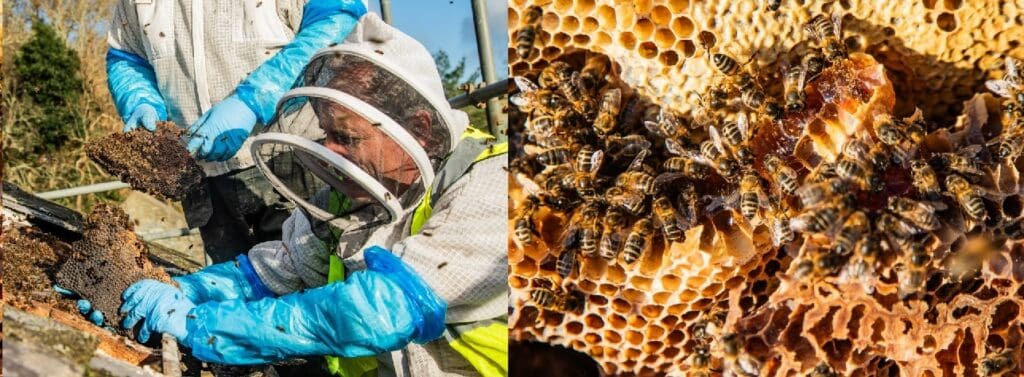Rare bees in the roof of a National Trust Cymru house in Wales are being temporarily re-homed while the building gets a new roof.
Beekeepers successfully moved five swarms of 50,000 Welsh black honeybees to nearby hives.
4000 Welsh slates from Penrhyn Quarry will be used for the first major re-roofing project in 200 years.
The survival of the building is due to the restoration work by three sisters, Eileen, Lorna and Honora Keating in the 1930s.
Sisters stipulated that the bees must always be protected after gifting it to the National Trust.
For the first time in 200 years the buzz in a National Trust house in Gwynedd, North Wales has been stilled, as a rare species of wild bees living in the roof have been moved to a new home during conservation work.
National Trust have embarked on a project to re-roof Plas yn Rhiw, believed to be the first time in over 200 years, but which has been made challenging by the need to find new temporary homes for the bees.
Five swarms with a total of about 50,000 Welsh black honeybees were living in the roof of the building. Thought to have died out in all but the most remote parts of northern Britain, the black honey bees were rediscovered in 2012 including in north Wales. SwarmCatcher, who specialise in the safe removal and relocation of bees were able to collect and move them to hives nearby.
Plas yn Rhiw is a picturesque manor house with an ornamental garden on the Llŷn Peninsula, which was rescued from neglect and lovingly restored by three sisters, Eileen, Lorna and Honora Keating after they acquired it in 1938.
Years later in 1952, the sisters placed the house in the care of National Trust with the unique condition that the bees in the roof should be cared for, stating: “We earnestly wish that the wild bees be undisturbed. May all occupiers of the property be requested to refrain from using poisonous sprays and preparations for the control of pests and advice on harmless methods be sought.”
While Plas yn Rhiw lies in its own micro-climate on the Llŷn Peninsula, it generally being milder, its biggest challenge during the winter months is high winds and heavy rainfall. Over the last 200 years the roof has been cared for and repaired in small patches, but recent severe weather has caused it to deteriorate requiring a complete new roof. The work will be carried out in sections with the old slates reused where possible as well as over 4,000 new Welsh slates from the Penrhyn quarry.
Mary Thomas, Property Operations Manager at Plas yn Rhiw said:
“We know the Keating sisters were very fond of nature and wildlife as they campaigned tirelessly to protect the environment and were ardent supporters of the Council for the Protection of Rural Wales.
“Plas yn Rhiw is a haven for wildlife and it is no surprise that when the Keatings restored the house, they made it a home for more than just themselves. Along with rabbits in the garden and badgers in the woodland, the bees living in the roof were welcome and remain so today, even when we occasionally have honey oozing from cracks in the walls in the summer!
“We were pleased to be able to relocate all of the five swarms we found safely to hives nearby while we undertake the work to the roof.”
It is uncommon to find bees in roof spaces, and more typical with old houses for bats to be accommodated when new roofs are needed. Plas yn Rhiw is home to common pipistrelle, soprano pipistrelle and whiskered/Brandt’s bats which are also being protected during the re-roofing project. In addition to maintaining access for the bats which roost in the roof, additional small gaps around the eaves and under the slates at the ends of the building will be carefully added so the bees can return to their old home. The beekeepers will then bring the hives back to Plas yn Rhiw’s orchard later this spring and allow the bees to find their own way back into their former home.
The house dates back to the 17th century, with the current roof built in 1820 when Captain Lewis Moore Bennet remodelled and enlarged the property from two to three floors.
Once completed, the newly watertight roof will also allow the house to become more energy efficient, reduce the humidity risk to the collection and redecoration of the rooms worst affected by the failing roof.
Mary Thomas added; “The work has been made possible through the Keatings’ legacy, although they’ve passed away, they’re still caring for the house.”
“We’re also grateful for everyone who visited over the summer and donated to sign a slate, we raised £625 in total with all proceeds going towards building conservation work at Plas yn Rhiw.”
The garden and parkland will reopen on 20 March, whilst the house remains closed as conservation work continues.

